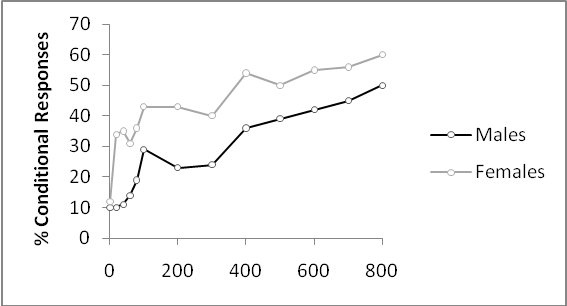| << Chapter < Page | Chapter >> Page > |


(Reproduced from data in Maren, 1994)
Fear conditioning resembles CEC in that during both paradigms learning occurs in response to an aversive stimulus. During fear conditioning, however, the animal learns to associate a particular contextual cue with the aversive stimulus, usually a foot-shock, and when they receive the cue they remember and prepare for the stimulus. This preparation typically consists of freezing in place (Dalla, 2009b). This type of experiment is carried out in a set up similar to the one shown in Photo 2 which is sound and light-proof to avoid environmental distractions. Generally, male rats demonstrate more spontaneous anxiety/fear in situations that are innately aversive, for example, males defecate more and move less in open fields, tend to enter and explore novel environments less frequently, and freeze more in response to unfamiliar sounds than females (Pryce, 1999).
Pryce (1999) studied the sex differences in responses to the fear-conditioning paradigm. He studied three different strains of rats; Wistar, Fischer, and Lewis. Males and females of each strain were trained to recognize an auditory cue that signaled foot shock. Freezing time was recorded for the initial training day, for a second day of cue and shock, and a third day in which the cue was given without shock. He found that female rats responded to the cues less frequently, in other words they froze less when they received contextual cues. On day one, all strains showed no sex-difference in percent of freezing. In later trials, male Fisher and Lewis rats exhibited significantly more freezing behavior , and Wistar males approached significance on the last trial (auditory only) (Pryce, 1999). This study showed some variation among different rat strains in fear conditioning and learning retention, but the general idea that males freeze more often holds true.
Several studies have concluded that the limbic structures, the amygdale and hippocampus, are important in fear conditioning (See [link] ). Associative long-term potentiation (LTP) has been proposed as the synaptic mechanism responsible for acquisition of fear conditioning in adult rats (Maren, 1994). This study, and others, shows that males have a higher magnitude of hippocampal LTP than females (Pryce, 1999).

Notification Switch
Would you like to follow the 'Mockingbird tales: readings in animal behavior' conversation and receive update notifications?